Review and Photos by Bokisaurus
Welcome to another dose of PNSO review! It sure is an exciting time to be a collector of prehistoric figures. Today, we will review another fabulous figure from the amazing company PNSO, the mighty Mosasaurus! So relax and enjoy the review.

Long before appearing in the Jurassic Park franchise, the marine reptile mosasaur was already a star. It is perhaps the most famous of all the marine reptile names, easily a household name.
Mosasaurus was also the first mosasaur to be named, having been discovered way back in 1764. The history of its discovery is rich and fascinating, but also too long to cover here.
During the mesozoic, various group of animals divided the different habitat. During the late Cretaceous, huge pterosaurs soared and ruled the skies, on land huge dinosaurs, both carnivores and herbivores, rules the landscape. These two worlds overlapped, each ruler keeping a weary eye on the skies or the land below them.
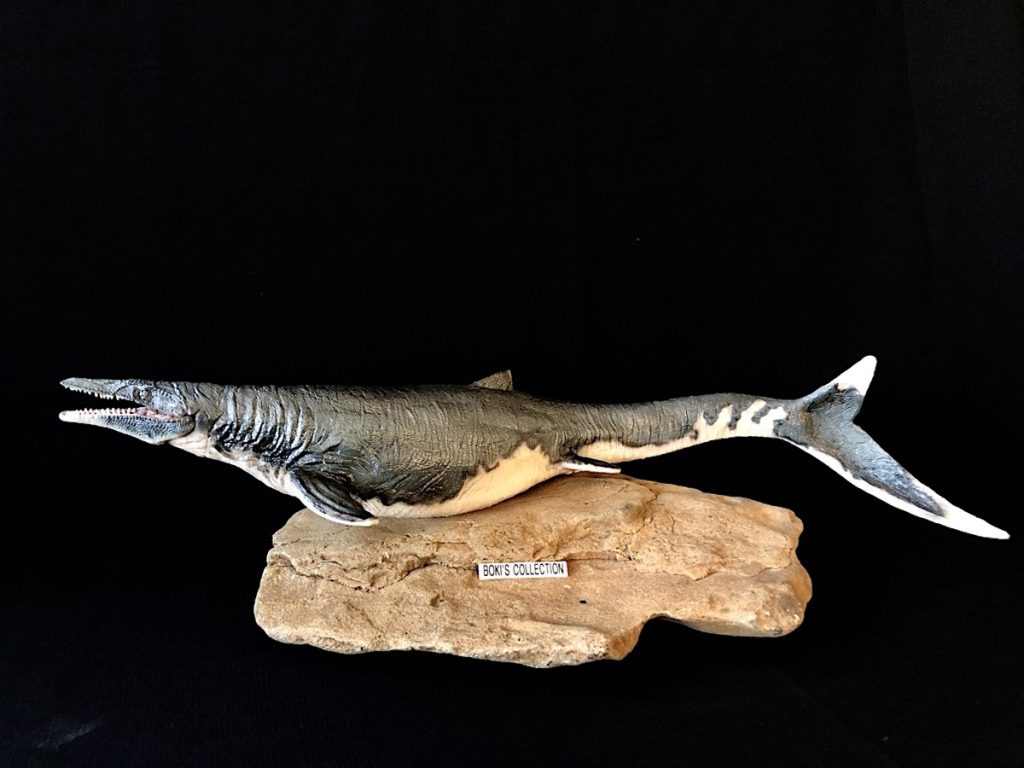
The third kingdom, the oceans, was different. It was hidden from view and difficult for any airborne or land based creature to penetrate. Here, in the dappled watery depths is where the marine reptiles dominated and one group rose to the top: the mosasaurs. To be fit to be called a king or queen, one must have the power, the strength , the size, and the ability to vanquish rivals. The mosasaurs met all those requirement, emerging as the top predators and rulers of the seas during the late Cretaceous.
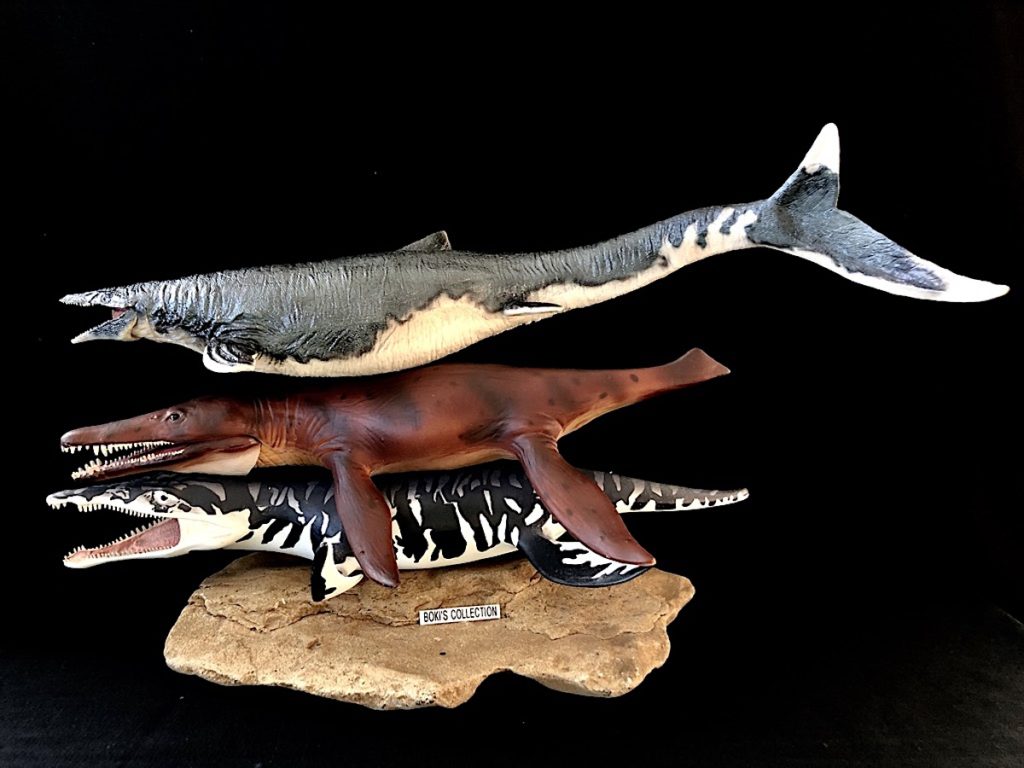
Once the ichthyosaurs and pliosaurs exited the stage, the mosasaurs diversified and took center stage. Mosasaurs belongs to the large family of mosasaurids who’s distribution spans the globe. Mosasaurus was one of the last and largest of the group, it existed during the late Cretaceous all the way up to the end. Their dominance was short compared to other groups of marine reptiles, going extinct by the close of the cretaceous along with the non-avian dinosaurs and all pterosaurs.

PNSO’s brief existence was full of ups and down.
Their previous series called Age of the Dinosaur was a huge success. This line contained some truly large figures of dinosaurs that were made of hollow plastic. When internal turmoil and chaos engulfed and derailed PNSO 2 years ago, it seems that any future planned releases went up in smoke. Then after complete silence the past two years, the company rose back from the ashes.
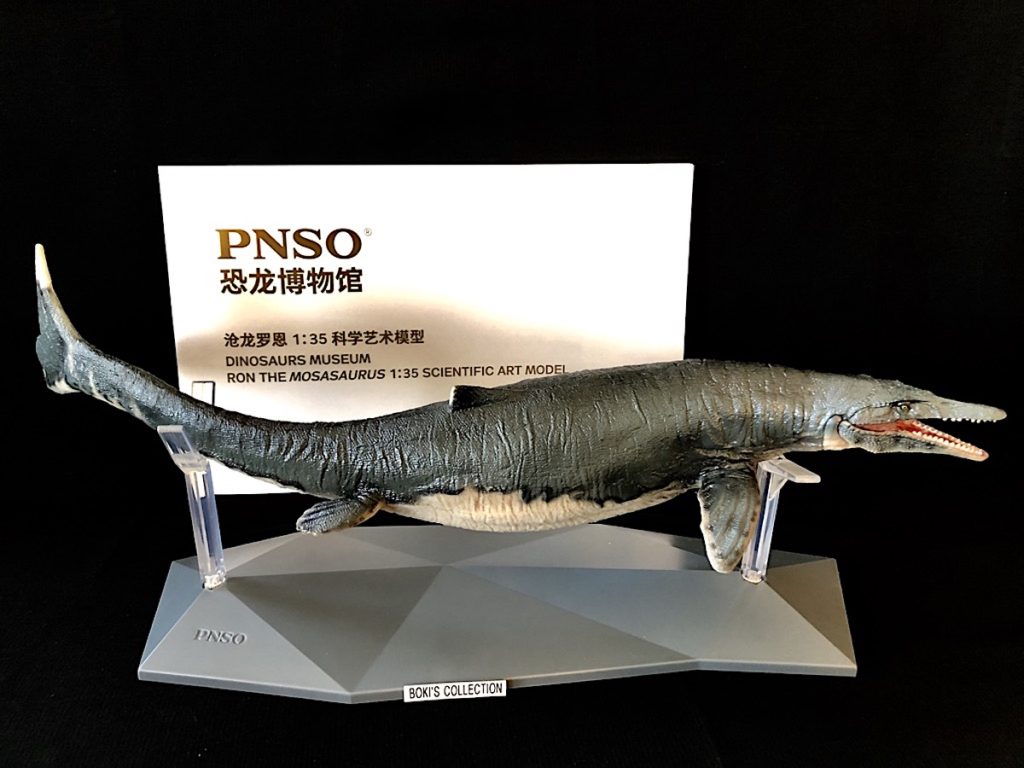
The newly emerged PNSO came back with some amazing set of mini figures. They then quickly followed it by releasing some of the long awaited large figures. The new line called Scientific Art Model was created for this set of large figures. The initial five figures were Amargasaurus, Opthalmosaurus, Ceratosaurus, the re-issued Mamenchisaurus, and our subject today, the Mosasaurus.
Each of these figures are packaged in elegant white boxes with the figures photo on the cover. The entire packaging includes a small booklet with photos of the model as well as some information about the animal in both English and Chinese. Oddly, no specific species is given, just the name Mosasaurus with size estimate of around 15 meters.

Based on the measurements, it is safe to assume that this is Mosasaurus hoffmanni, the largest of the mosasaurs with size estimates up to 17 meter (around 56 ft).
Officially listed at 1:35 scale, this is one big bad boy! The figure measures a good 12” inches ( a foot) from nose-tip to tail-tip stretched out!
At a glance, the figure is really impressive and one would notice how robust the body and tail are when compared to the small pointy head.
Mosasaurs are marine lizards that grew to impressive size. Their closest living relatives are the snakes and monitor lizards.This lineage is very noticeable in how the head looks, in fact, if you look at the head, it looks very much like that of its extant cousins, the monitor lizards.
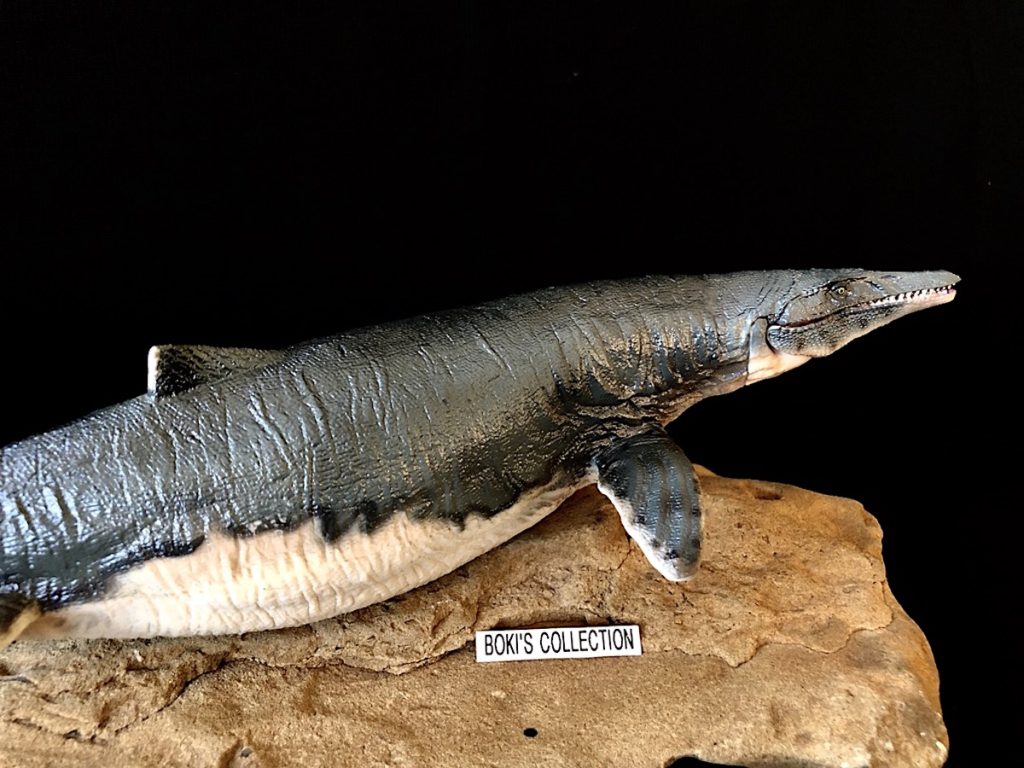
In life, the head of Mosasaurus is narrow and pointy. The skull tapered off into a short snout with strong conical tip.It may look small especially when compared to some of the large Pliosaurus before it, but when compared to other mosasaurs, one can see that its skull is really more robust with tight jaw attachments.
The figure faithfully capture this head shape nicely. The lower jaw is articulated, so you have the option of having this bad boy with closed mouth for a more relaxed pose, or wide open for a more menacing look.
And speaking of menacing, Mosasaurus’s jaws were armed with massive teeth that are conical in shape. The figure’s teeth are nicely sculpted and are about the right size. The paint application on the teeth are precise and very clean, at least on my figure.
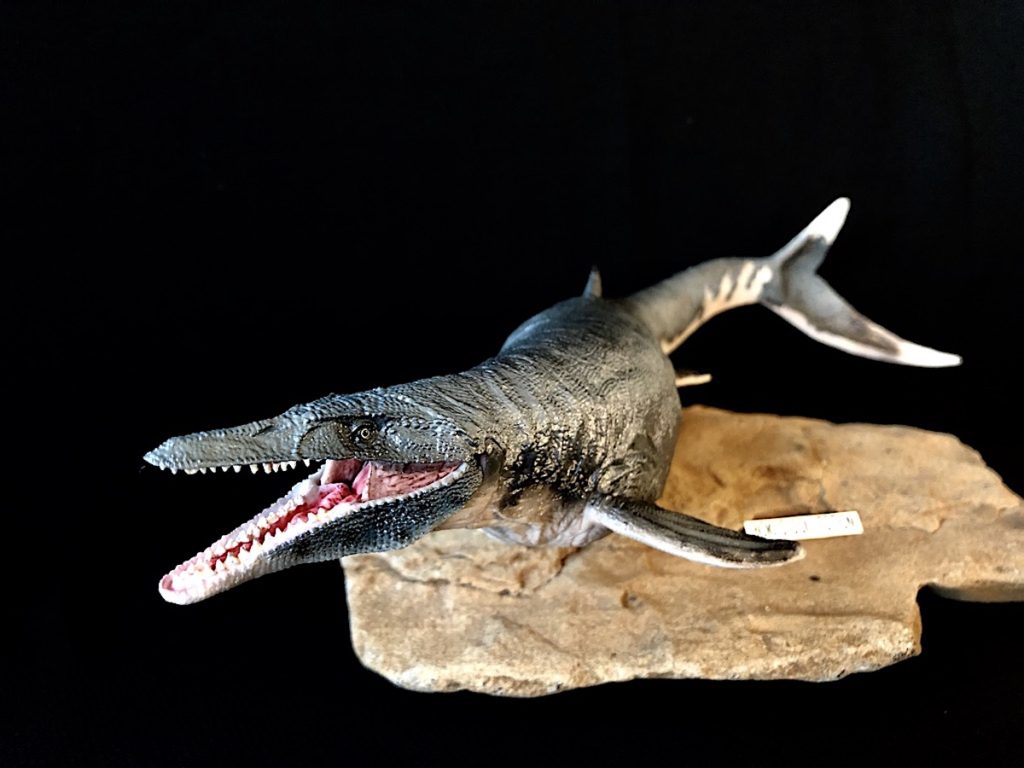
I’m no expert on marine reptiles, but based on some of the fossil photos (which can be very confusing,) maybe the very front teeth reached all the way to the tip of the snout instead of leaving a gap or space for the bony tip. Either way, it’s still in line with some photos of the head fossil that I saw. And speaking of teeth, the unique and very distinctive pterygoid teeth on the roof of the mouth, a feature that enable it to have a better grip on struggling prey, is really well done and visible.
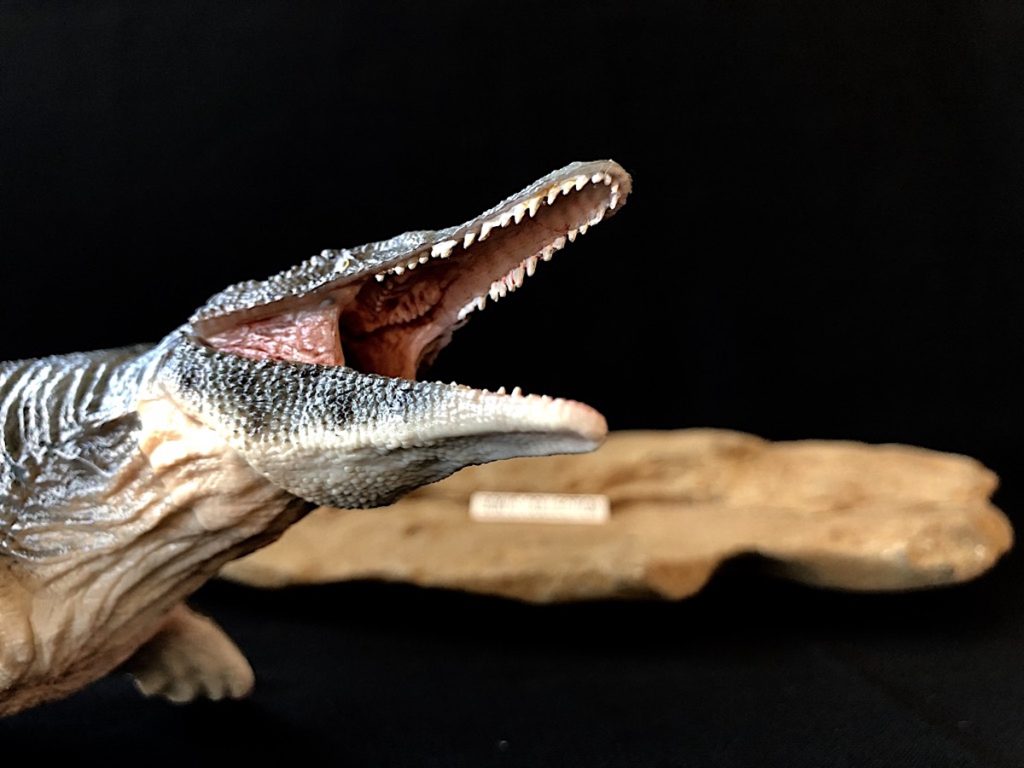
Unlike the more robustly built pliosaurs, the mosasaurus’s body is rather long and slender. In the past, body shape was often depicted as looking very similar to that of an ell or snake. But this is not the case. Although slender, mosasaurus did not have a serpentine body.
The body is muscular as well as stocky and very much like that of a monitor lizard. Mosasaurs are top predators of the seas. Their limbs were modified into paddles, however, unlike the pliosaurs, these paddles are shorter and one can still see some clearly defined limb bones that are widely spaced out and webbed. The front paddles are also larger than that of the hind ones.

The PNSO model show these characteristic very well. Deep groves on the paddle show where the digits are. These flippers attachments to the main body, luckily, are not too thin, something commonly seen in other marine reptiles. In the figure, these attachments are muscular and covered in wrinkles as they should be for such large powerful animal.
There are no shortage of skin wrinkles and scales on this guy. These wrinkles are scattered all over the body, but are concentrated in areas where the paddles attach, as well as those areas around the neck. Skin wrinkles/fold on marine reptiles are still controversial. Some think that they should be smooth, like whales, while others think otherwise.
Looking at their extant relatives such as monitor lizards, skins folds and wrinkles are not far fetch. Perhaps just a little more on the back part than necessary, but that is so minor in my book.
Too often, marine reptiles such as the pliosaurs, are depicted as very smooth with hardly any signs of scales, or the opposite where the scales are too large.
PNSO managed to balance it in their mosasaur figure. The body is covered in very small and delicate scales, not very visible from afar, but up close, you can see the details very well. These minute scales are mixed in with the skin wrinkles and makes a realistic and very pleasing effect.

The overall body coloration is two toned. A dark, bluish-gray dominated the upper part of the body, while a cream color dominate the lower half. This is inline to what one might see in large ocean going predators today like sharks and whales, so it’s highly likely that prehistoric marine predators also had this countershading colorations in their body.
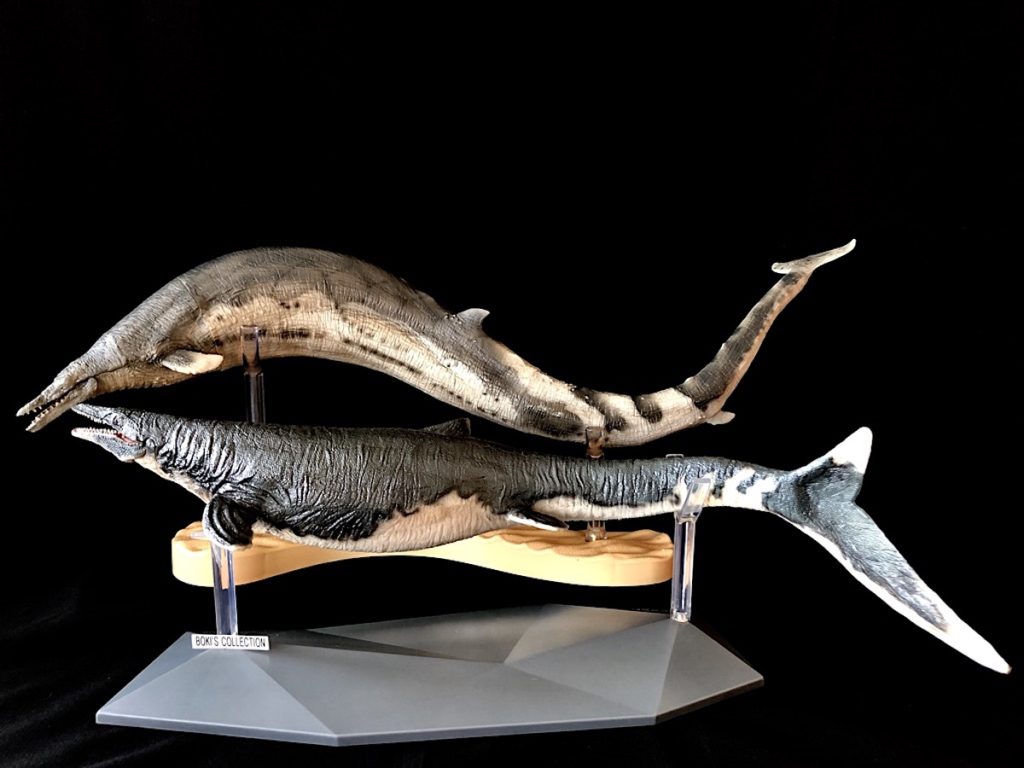
The line where the two color meets are highlighted by a black band forming irregular patterns, a really subtle but effective design.
Perhaps one feature that one would notice on this figure is that it has a dorsal fin, yes that’s right, a dorsal fin on its back, like that of a whale.
Now, there is no fossil evidence of dorsal fin ever being found on a mosasaur before, so I think it is purely artistic license.

The fin ridge that was once and still is commonly seen in older mosasaur art depiction, as well as toy figure such as the one in the original Carnegie figure, were not the same as a dorsal fin. These dorsal ridges were from another part of the animal that was mistakenly placed on the top during restoration. When the mistake was realized, the dorsal ridge was already popular and remain to be so even today.
That being said, although no evidence of dorsal fins on mosasaurs are currently known, it is not entirely impossible that they may have had one. After all it was not that long ago that tail fluke on mosasaurs were absent and it was believed that they did not have one, that is until a fossil showing clear impressions of it was finally discovered. So, who knows, maybe one day evidence of a dorsal fin may show up after all, just like the tail fluke.
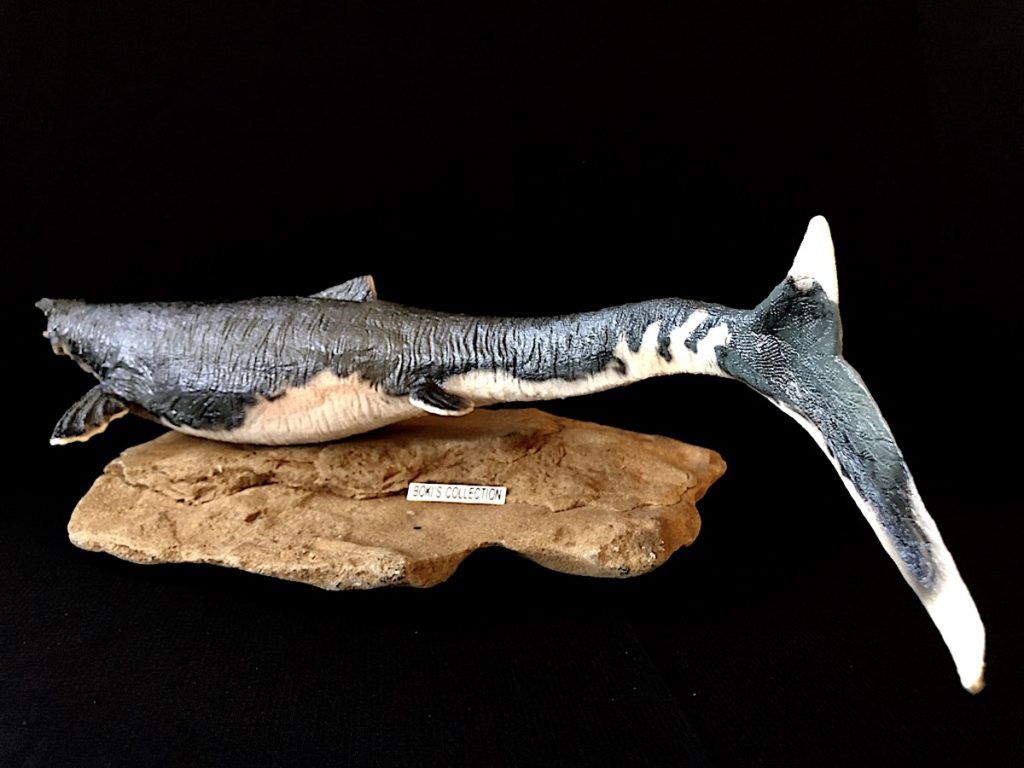
And speaking of tail fluke, this big boy have a big and beautiful tail. It really is impressive and beautifully done.Here too one can see some small delicate scales along the middle part of the tail mixed in with skin wrinkles. You can see the shape of the bone underneath the flesh.
The top lobe is smaller and is colored white, while the lower lobe is much longer and also colored white. The dark body color goes all the way town to the tail where it covers the middle part of it.
Prior to finding evidence of tail fluke, mosasaur tails were often depicted as a long tail ringed with small skin flaps, very much like a salamander or a tadpole’s tail. An it was believed that mosasaurs swam in an ell-like fashion, swaying their entire bodies from side-to-side.
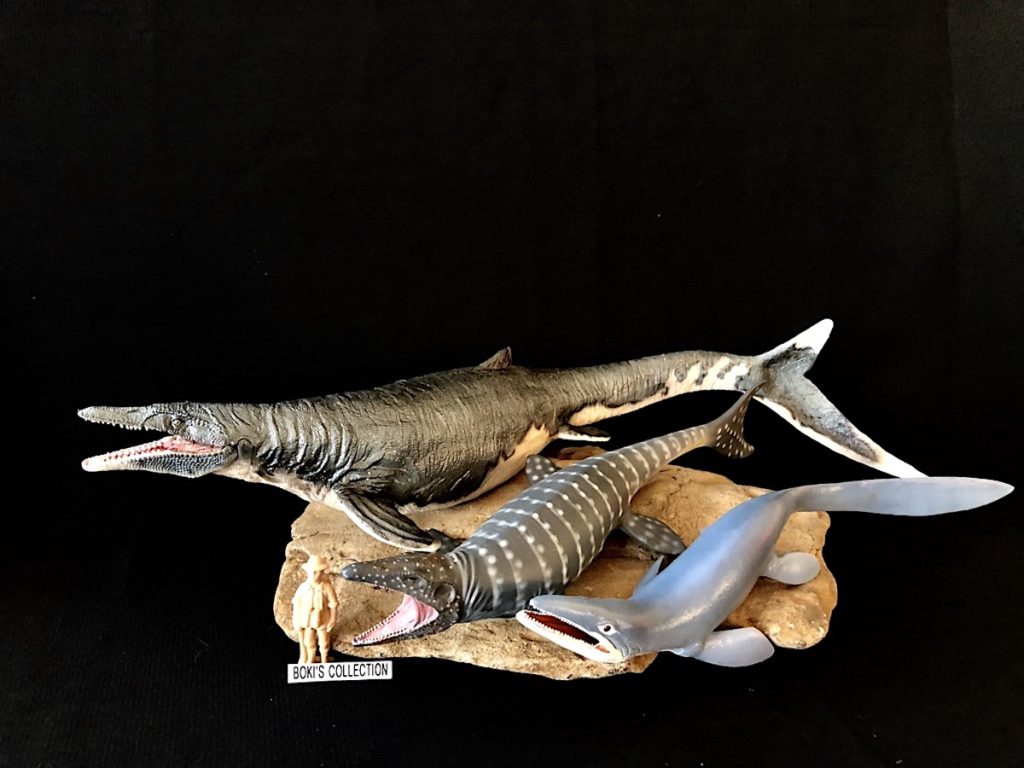
Now, with the tail fluke evidence, how mosasaurs propel themselves have been revised. With such powerful tail and muscles, it is now believed that mosasaurs held their bodies more stiff, using its tail fluke as their main way of propelling themselves at great speed.
Mosasaurs inhabited many different watery environment, while some preferred lagoons and shallow reefs, and even freshwater s, others such as mosasaurus most likely inhabited the deeper open ocean. Although strong swimmers, it is highly unlikely that Mosasaurus can dive to great depth, instead, they probably stayed at or near the surface where prey are more abundant. They have truly dominated the late Cretaceous, expanding their reign almost globally.
Diet of mosasaurs is pretty simple: they ate pretty much everything they can catch. Evidence from stomach contents reveal ammonites. fishes, turtles, birds, as well as other marine reptiles were all in the menu. And it is likely that mosasaurus was also opportunistic and would not turn its nose from scavenging , so dinosaur carcasses washed out to sea are fair game. Its ability to expand its jaw to accommodate larger prey really makes them the apex ocean going predator of the late Cretaceous seas.
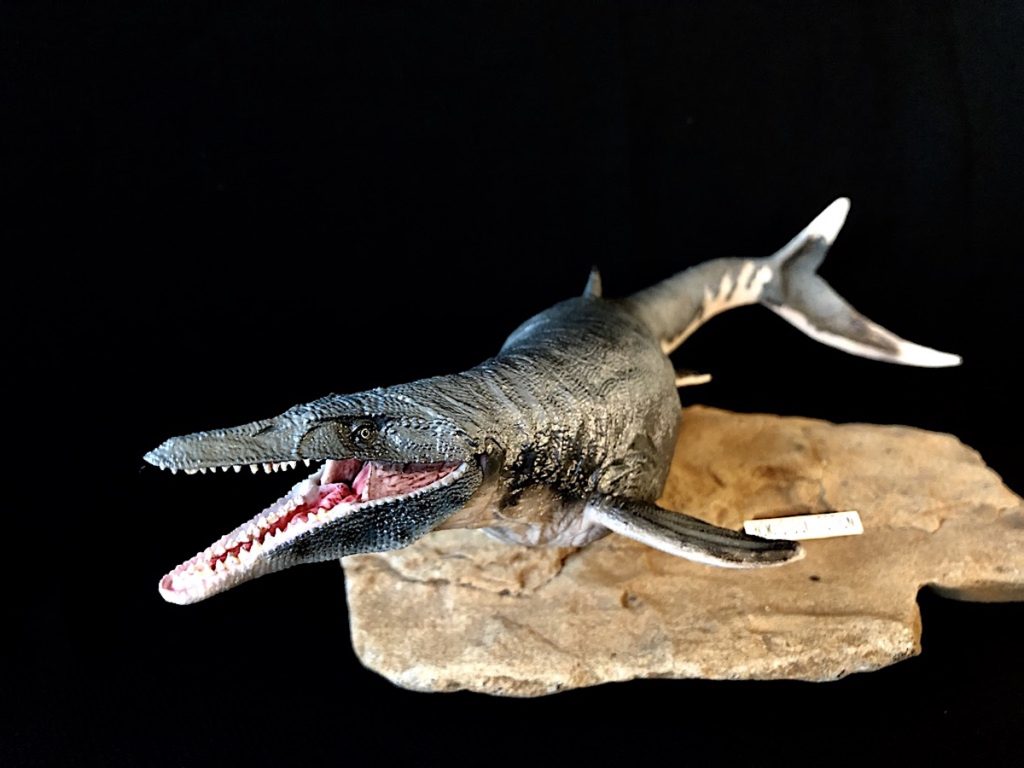
Although mosasaurus was purely aquatic, it is a marine reptile so they need to surface to breath air. It is highly unlikely that mosasaurus can survive for long outside of water. Like today’s whales, the sheer weight of the animal will surely crush its lungs if stranded on land for long. Like the ichthyosaurs before them, and today’s whales, mosasaurus also gave birth to live young in the open ocean.
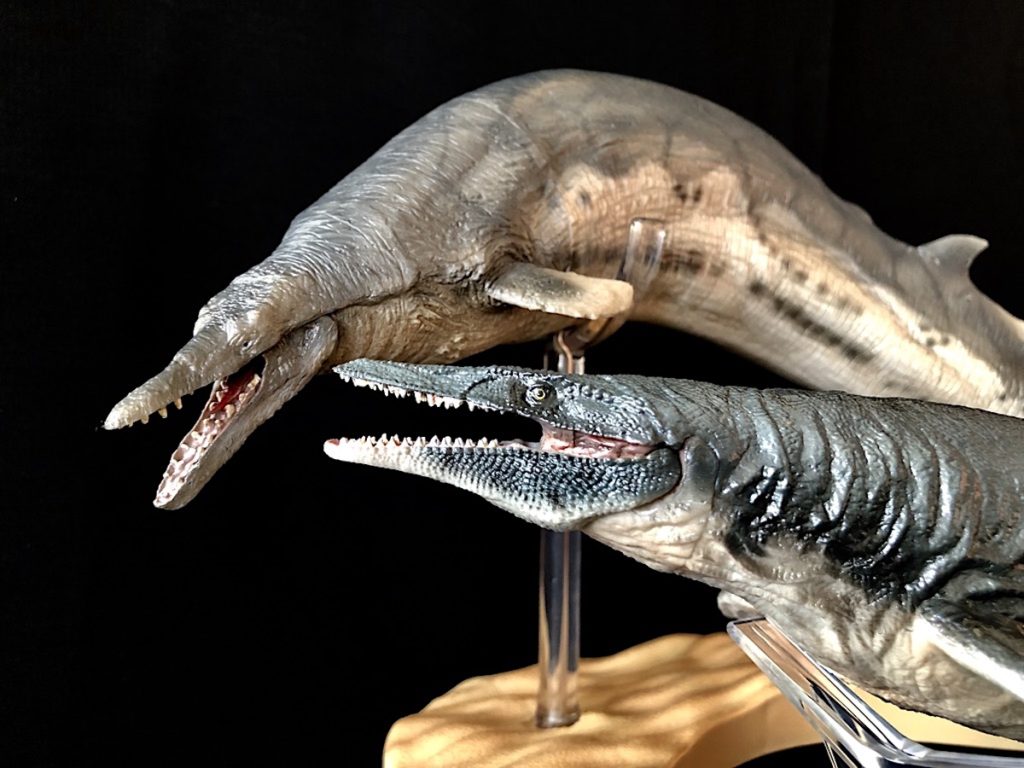
At the end of the Cretaceous, a catastrophic event occurred that would change the whole history of life on earth.Along with the non-avian dinosaurs that ruled the land, and all those majestic pterosaurs who freely ruled the skies above, the reign of the mosasaurs and all other marine reptiles came to an abrupt and tragic end.
With the extinction of these giant marine reptiles, the worlds oceans will never see such impressive beast again.
It is odd that in the long evolutionary history since the demise of the marine reptiles that no other group of animals evolve in the same form. Throughout natures history, there are countless instances of convergent evolution. Animals unrelated to each other, yet evolving very similar shapes. After all, the marine reptiles have been around for millions of years, so these shapes and body plan must be very successful.
Also, many reptiles escaped and survived the extinction event, but non of them reverted back to a completely aquatic life like the ancestors of the mosasaurs, pliosaurs, and plesiosaurs did.
It is only the ichthyosaur’s body plan that escaped total extinction. We see this body design in today’s dolphins, a reminder of these prehistoric beast that once rules the oceans.
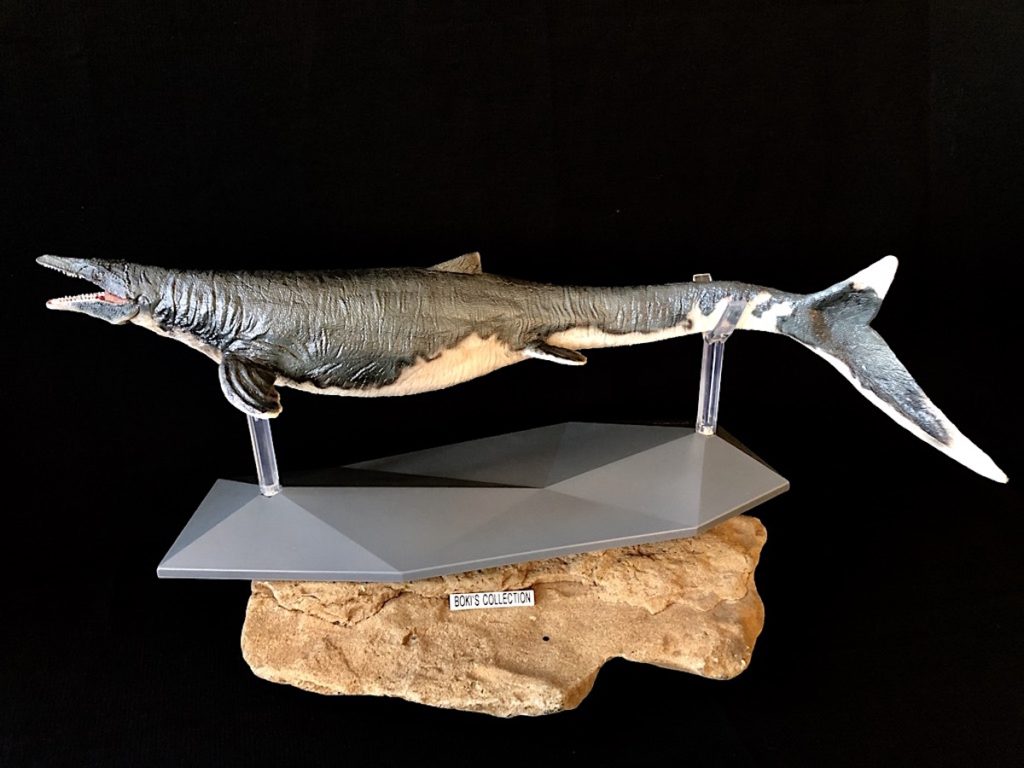
In closing, this is one solid figure that shouldn’t be missed. PNSO’s new line of large figures have managed to successfully straddle the fine line between toy and high end desktop figure.
The solid PVC material is durable enough to withstand play, at the same time, the high quality production, research, and exquisite attention to details makes them a true work of art that rivals, and even exceeds, some of the higher priced resin models.
The figure is not perfect, but nearly so. If you are like me who is not too hang up on little artistic license inaccuracy ( for now at least), then this is definitely a must have figure to add to your collection.
This is the one figure that would surely inspire admiration from anyone who sees it and will be the undisputed start of your marine reptile collection.
I hope that this revival will continue, and that we will see more of these high quality figures from PNSO in the very near future.
That concludes today’s review. Thanks for reading, I hope you like it. Until the next one, cheers!
Disclaimer: links to Ebay and Amazon on the DinoToyBlog are affiliate links, so we make a small commission if you use them. Thanks for supporting us!





A beautiful figure but I hesitate to buy it. Current thinking regarding mosasaurs is that their overall length was roughly 7 times their skull length (as opposed to 10 times which has been used for decades, without any rationale). This 7:1 ratio is based on a Prognathodon skeleton found a few years ago.
If that’s the case, and it makes a lot of sense to me that it is, then the head on this model is too small for the body. It’s a shame PNSO didn’t incorporate the latest science into this figure……it seems they stuck with the familiar small head on a long body restoration of Mosasaurus. that has been used for a long time.
I never commented here before, but this Review i just read for the 2nd or 3rd time, is really well done. Thank you for this detailed look Boki. It is always a real pleasure to read your Reviews and look at your perfectly angled Photos that go hand in hand with your Words.
Regards.
As with almost all of PNSO’s figures, the accuracy of this Mosasur is off the charts. Just got it and couldn’t agree more. 5 Stars all the way.
It’s the definitive Mosasaurus figure for me.
I really love how big this one is!
Your reviews are always the highlight of my in box. Both educational and very readable, thanks so much!
That’s very kind of you, glad to hear you enjoy ready my reviews, means a lot.
Cheers!
Terrific review as always. I love the tail fluke on this sucker. And it’s so great to finally see a BIG mosasaur toy that can go toe to toe with all the giant pliosaur toys.
PNSO just keeps making slam dunk after slam dunk.
Yep, really gone those impressive pluosaurs a run! Haha!
That’s one very thorough and well-illustrated review – nice work! I will be ordering this one eventually, finances permitting; so many temptations at the moment and a finite budget to prioritize. The comparison images with other figures are really helpful in terms of showing the size, a valuable addition to a great review.
Glad you like it. Yeah, it will be a hole before I can afford the other two!
It really was a very hard choice to decide which ones to order first!
Fantastic review and pics! I’m having to fight off temptation to get this one, your review has made this temptation all the greater!
Hahaha! You won’t be disappointed by this figure for sure. Worth saving up $ and space to display it, hehehe!
I congratulate you Bokisaurus for your extensive comment. For me it is the best mosasaurus made in mass to date, far exceeding that of Safari and Collecta, although as you say the artistic license of the dorsal fin is one of the few things that can be reproached to sculpture.
I have this figure and it is made of a mazico plastic and it is more a figure destined for collectors, but due to its resistant model to blows and abrasions it is ideal even for children being a figure for collectors / amateurs or a figure more destined to the showcases of a Museum. Superb review for a magnificent figure PNSO brand starts the year on the right foot.
Thank you! I’m glad you were able to get the figure.